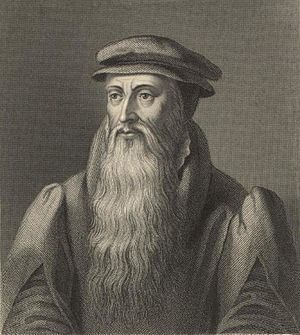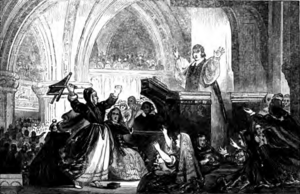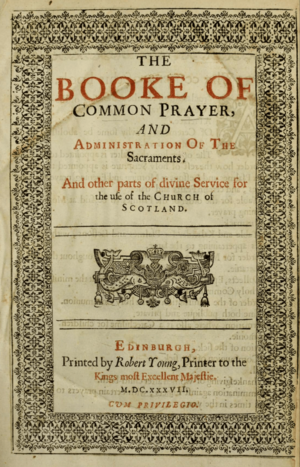Scottish Prayer Book (1637) facts for kids
The 1637 Book of Common Prayer was a special prayer book made for the Church of Scotland. People also called it the Scottish Prayer Book or Scottish liturgy. It was based on the English Book of Common Prayer but had some changes.
This book was a lot like the very first English prayer book from 1549. It included ideas from church leaders who wanted worship to be more traditional, like older Catholic rites. However, it also tried to include some things that Scottish people and Presbyterians might like.
King Charles I, who ruled both Scotland and England, wanted to make worship in Scotland more like worship in England. He tried to make everyone use this new prayer book. But many Scots did not agree with this. There were many protests, including a famous one by Jenny Geddes at St Giles' Cathedral. Because of these protests, the 1637 prayer book was rejected.
Contents
Why a New Prayer Book?
Kings Want to Unite Churches

In 1603, James VI of Scotland also became King James I of England. This meant one king ruled both countries, but Scotland and England were still separate.
When James went to London, a group called the Puritans asked him to change the English church. They wanted it to be more like the Scottish church, which was Presbyterian. The Puritans hoped their new Scottish king would agree with them. But King James decided to support the English church's ways instead. He even tried to make the Scottish church more like the English one.
In England, there were arguments about how church services should be held. The 1559 English prayer book was the official one, but people used it differently. In Scotland, John Knox had created a very different prayer book in 1559, called the Book of Common Order. This book was based on ideas from John Calvin in Geneva. It was much more Protestant than the English book.
Many Scots strongly disliked the English prayer book. They thought English worship was "little better than when it was at the worst."
King James's Efforts
Instead of agreeing with the Puritans, King James held a meeting in 1604 called the Hampton Court Conference. He decided to make only small changes to the English prayer book. The new 1604 English prayer book ended up favoring the bishops even more. English Puritans were not happy about this.
However, King James kept pushing the Scottish church to become more like the English church. By 1617, he started changing his royal chapel in Scotland to fit English services. He also made the Scottish church adopt some English practices, like kneeling during Communion. These changes were not popular and faced a lot of resistance.
Some church leaders in England, like William Laud, wanted worship to be even more traditional. They liked the older 1549 English prayer book better than the newer ones. They believed the Church of England should be more like the early Christian church.
King Charles I Takes Over
When King James died, Charles I became the new king. He also wanted to create a new prayer book for Scotland. In 1633, Charles visited Scotland, and William Laud became the main archbishop in England.
Charles and Laud wanted to use the 1604 English prayer book in Scotland. But Scottish bishops wanted a new service book made just for Scotland. They had some problems with the English prayer book, like it using an older Bible translation instead of the popular 1611 King James Version.
So, a new prayer book was created for Scotland. It was heavily influenced by the 1549 English prayer book and the ideas of traditional church leaders.
The Scottish People's Reaction
Protests and Rejection

On Sunday, 23 July 1637, the new prayer book was used for the first time. It was immediately met with strong protests. These protests were planned carefully. The most famous event happened at St Giles' Cathedral.
As the Communion service began, a woman named Jenny Geddes is said to have thrown a stool at the bishop. She supposedly yelled, "Villain! Dare you say Mass in my ear?" (meaning, "How dare you say a Catholic-style service so close to me!"). Another bishop, Walter Whitford, knew about these strong feelings. He held his first service with two loaded pistols on the desk in front of him!
King Charles trusted his Scottish council to handle the protests. But soon, the protests grew into a revolution. Many people felt that the new prayer book was the "last drop" that made things overflow. They believed it was a big step towards making the Scottish church too much like the English church, or even too Catholic. Some historians believe that trying to force this prayer book on Scotland helped cause the wars that followed soon after.
Later Influence
Changes to the English Prayer Book
After King Charles II returned to power in 1660, there was a need to revise the English prayer book. Two church leaders, William Wren and John Cosin, used their experience with the 1637 Scottish prayer book to make changes. They often borrowed ideas and even exact words from the 1637 book when creating the 1662 English prayer book.
Scottish Nonjurors
The 1637 prayer book was used again later by a group in Scotland called the Nonjurors. They were a group who did not swear loyalty to the new king after 1688. They liked the 1637 book because it was more traditional. New versions of the 1637 text were published in the early 1700s.
What Was Inside the Book?
The 1637 Scottish Book of Common Prayer was seen as a mix of the English prayer book and more traditional ideas. However, it also tried to include some things for its Scottish users. For example, it used the word presbyter (meaning elder or minister) instead of priest (which sounded more Catholic to some). But King Charles I refused some changes that would have made it even more Scottish.
The Scottish church leaders wanted fewer special feast days in the calendar than the English prayer book had. But King Charles I insisted on including 29 feast days. The Scottish calendar also added 15 Scottish saints. The book also used Scottish words like Pasch instead of Easter and Yule instead of Christmas.
The Scottish churchmen wanted to remove parts of the Apocrypha (extra books not in the main Bible) from the readings. But King Charles I made sure 12 chapters from these books stayed in for certain saints' days. However, since celebrating these saints' days was not required in Scotland, the Scots could avoid reading them.
Communion Service
The Communion service in the 1637 book was changed to be more like the 1549 English prayer book. It added some sentences for the offering. It also included a prayer for the dead, which had been removed from later English prayer books. The most important part, the "Prayer of Consecration," combined several prayers. This was different from the Scottish Book of Common Order and was criticized.
Marriage Service
The 1637 marriage service was not used much. In this book, the wedding ring was placed on the left hand. This was a change from older traditions where it was placed on the right hand.
Was it "Popish"?
People argued a lot about whether the 1637 prayer book was too "Catholic" or "popish." Some historians say that these claims have not been proven by scholars. However, others believe the Scottish prayer book was indeed more Catholic in its practices than the English one.
Historians also say that King Charles I played a very big role in creating the book. He might have wanted to make worship the same across all of Britain using this book. Some believe that Laud and Charles thought Scotland would be an easier place to start these changes. But they were wrong.
See also
- Book of Common Prayer (Unitarian)
- Exhortation and Litany


